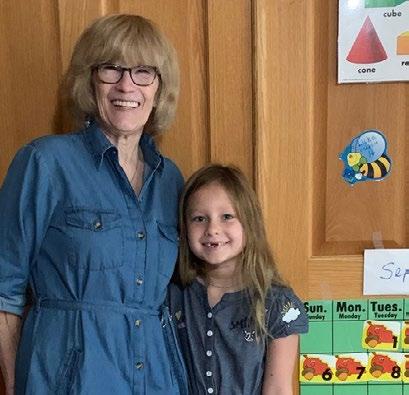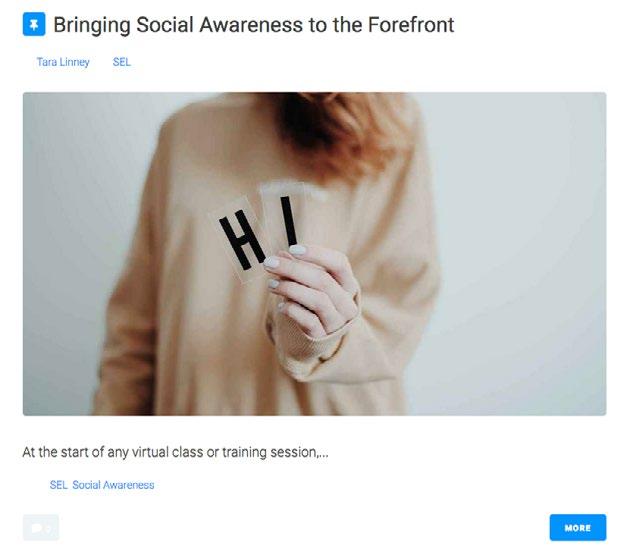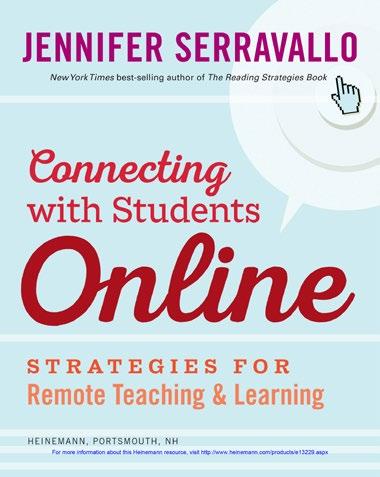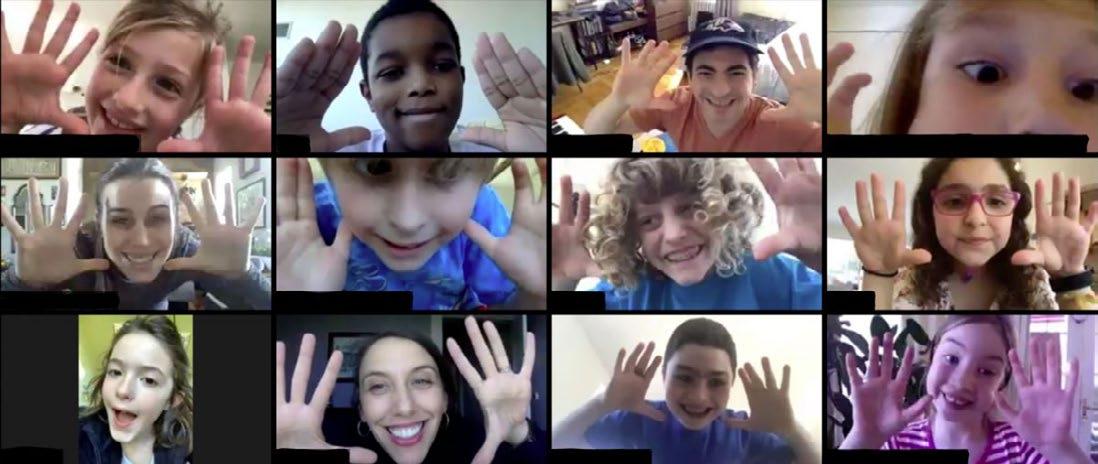
10 minute read
Grandmother’s Perspective
Article
Christine Layton
A Grandmother’s And Retired Teacher’s Perspective On E-Learning
As we all continue to navigate the unprecedented waters the COVID-19 pandemic has flung us into for these last ten months, perhaps no lives have been more impacted than those of American educators, students, parents, and, yes, even grandparents.
When I retired from teaching elementary school in 2008 to focus on my growing family of grandchildren, I soon realized that I desperately missed my classroom. Teaching is my passion. For many years after my retirement I found fulfillment as a substitute teacher in McHenry, Illinois my former school district. Four years ago, I stopped “subbing” so I could help care for my two youngest grandchildren.
Fast forward to March 2020. COVID-19 officially hit the United States, and schools across the country ceased in-person instruction. The world suddenly got smaller. My grandson Luke was in second grade and my granddaughter Anna was in kindergarten when they were required to participate in a remote-learning model that had never been tested before. Naturally, their school was unprepared, but they did their best to adapt. No one assumed the e-learning would last more than two weeks, so the curriculum was not robust and
my grandchildren were rarely, if ever, connecting with their teachers.
When it became clear, over the summer, that their school would not be able to safely return to in-person instruction for the fall, I offered to assist with Luke and Anna’s e-learning. Having taught first, second, and third grades, I knew I was qualified to help. For the start of the 2020-2021 academic year, their school had developed a more rigorous curriculum that included both synchronous learning, via Zoom with teachers, as well as asynchronous, independent learning, via various computer programs. Each child was assigned their own preloaded Chromebook from the school. Materials and supplies were delivered to the students’ doorsteps. My plan was to teach both Luke and Anna at my home. Luke would be more challenging to teach, as he has an Individualized Education Program (“IEP”} and requires more time and resources than other third graders. However, I soon realized that an IEP was not my biggest hurdle. After all, I taught classrooms averaging 23 students with varying abilities and needs for years. The biggest challenge for me was learning the technology!
The first day I attempted to assist both kids with e-learning from my home was terrifying, stressful, and eye-opening! I found the Chromebook screens to be too small, so I set Luke up on my large PC upstairs, and set Anna up on my husband’s PC downstairs. The morning began with me literally running from child to child, trying to set them up for their morning class meetings via Zoom. Prior to this day, I had limited experience using Zoom and zero experience using Google Classroom, which is the platform their teachers use to post daily agendas links, and other useful information. Once I had Anna comfortable, I rushed to help Luke. He was panicking because, for reasons we still don’t understand, a polka song in my computer’s music library started blaring during his class Zoom meeting. I was mortified, as I tried to stop the music. Meanwhile, Luke, Anna, and a boy in Luke’s class all started dancing around. I tried to mute Luke’s connection, but I couldn’t figure it out. I finally apologized to the teacher and completely shut down the computer. We were all laughing hysterically. But, that day marked the end of me trying to help both kids simultaneously with their e-learning.
From there, my son decided to take time off from his job, so he could assist Luke with his e-learning, and I continued to take Anna every day to my house to help her. In order to foster a successful e-learning environment for my granddaughter I have to wear two hats: loving “Grammy,” as Anna calls me,
and teacher. For the most part, during the hours between 8:30 a.m. and 3:00 p.m., Monday through Friday, I have to keep that teacher hat on. I have to be firm, I have to be patient, and I have to be adept at redirecting Anna in an atypical learning environment. I thought I could count on Anna to show me how to use the technology. At first, even if I could find the right site, I could not figure out how to properly save her work. With the help of Anna and her STEM class sessions, I began to learn. Now, five months in, of school children across this country this year, technology is by no means perfect. We regularly lose our internet connection, and we get dropped from Anna’s Zoom calls. In addition, the asynchronous work Anna’s teacher Mrs. Wheaton assigns on various computer programs does not always keep Anna’s interest or does not keep her busy enough to fill the time before her next Zoom call. Fortunately, I can rely on the many first-grade workbooks I kept from my teaching days to keep Anna busy. I
I thought I could count on Anna to show me how to use the technology. At first, even if I could find the right site, I could not figure out how to properly save her work... Now, five months in, I can toggle back and forth between Google Classroom, Clever, Seesaw, Lexia, Dreambox, Imagine Literacy, Imagine Math, etc.
I can toggle back and forth between Google Classroom, Clever, Seesaw, Lexia, Dreambox, Imagine Literacy, Imagine Math, etc. When I retired from teaching, these programs were not used—teachers had only just started using email. Now, my comfort level with using technology has grown exponentially.
Although technology is amazing, and it’s facilitating e-learning for millions also create science projects for us, we bake cookies together, and we take walks in the wood to keep Anna learning in nontraditional ways. Without my worksheets and lessons, Anna would have a difficult time staying on task, and I fear she would lose interest in e-learning altogether.
Certainly, these are challenges that all schools are facing as the months of e-learning continues. How do teachers
keep students engaged with nothing but a computer screen between them? I’ve observed Mrs. Wheaton doing a It was an e-learning moment and a connection between grandmother and granddaughter that I will never forget.
fantastic job of bridging that gap. Every day, Mrs. Wheaton starts with a Zoom meeting, wherein she greets each child and plays a song. She and the school social worker also stress the importance of strengthening the social-emotional connections by employing many Calm Classroom lessons. These exercises help the kids focus on mindfulness, physical awareness and, most importantly, calmness, during these trying times. The children are walked through steps on deep breathing, sitting still, and relaxing their bodies. A recent exercise introduced during Calm Classroom is called “external gazing.” Anna insisted that I participate in this because she assumed it was a staring contest, which she wanted to win. After many days of her “winning,” I decided to truly focus on the intended calming effect of this exercise. While I was lost in our locked gaze Ana surprised me by whispering, “You’re beautiful, Grammy,” with such sincerity and love, I almost cried. Connecting with her classmates and her teacher in this e-learning environment has not been easy for Anna. Thankfully, in recent weeks, Mrs. Wheaton has mastered the use of Zoom breakout rooms and incorporated these connections in her daily curriculum. The breakout rooms allow students to pair with one or two peers for math, reading or much-needed socialization. Mrs. Wheaton can go back and forth among the breakout rooms to ensure that her students are being respectful and staying on-task. Being able to connect with other children, even if only virtually, has made Anna so happy these last few weeks. Mrs. Wheaton does a great job of making e-learning as fun as possible for her students. She uses a Bitmoji classroom, which she updates daily, and she sends regular newsletter to parents via email. She also provides an entire virtual library for her students to access, and she encourages her students to record themselves reading to her in Seesaw so she can monitor their progress.
Having taught several grade levels in the classroom, I understand how crucial first grade is for a child’s academic development. For example, most children come into first grade just starting to sound out words on their own and, by the end of the school year, they are reading fluently. Their math skills grow by leaps and bounds in first grade. Writing is also an important skill that I worked on with my first grade students daily. Every morning in my classroom, I would post a question on the board, and the students would have to write a journal entry in response to the question. I could walk around the classroom, help students spell tricky words and observe their writing styles. How do teachers accomplish this in a virtual environment? It’s beyond difficult, but Mrs. Wheaton tries her best to work on writing in small groups with her students via Zoom. Anna is very fortunate to have me, a retired schoolteacher, to work directly with her on reading, math and writing.
By no means is e-learning a sustainable way to educate a child, but I’ve come to appreciate all of the positives involved in this preternatural situation. Being here to assist my granddaughter has given me a renewed sense of purpose. I feel so much pride watching her grow and learn daily. Aside from the annual Grandparent’s Day visit at her school, the occasional stint as a Mystery Reader in her classroom, I would not have access to her education like I do now.
On the other hand, if Anna were in school full time, she would not be with me for hours every day, teaching me patience, helping me learn technology and, after a recent adverse reaction to a medication I was taking, potentially saving my life by calling 911. We have grown so close. I know we are both eager for her to return to a normal school setting, I will miss these days and look back at them fondly, including the crazy moments, the frustrating moments, and the polka-song fiasco! The world got smaller this year, but my passion for teaching, dormant for years as a retiree, grew.
Christine Layton is a 72-year-old retired teacher and a “tutoring grandmother.” She lives in Ingleside Illinois with her husband of 55 years. Christine has three sons, seven grandchildren, and one greatgranddaughter.


An ISBE Approved Provider

All Learning Is Social and Emotional: Helping Students Develop Essential Skills for the Classroom and Beyond with Nancy Frey
April 29, 2021
While social and emotional learning (SEL) is most familiar as compartmentalized programs separate from academics, the truth is, all learning is social and emotional.
If you teach kids rather than standards, and if you want all kids to get what they need to thrive, Nancy Frey offers a solution: a comprehensive, five-part model of SEL that’s easy to integrate into everyday content instruction, no matter what subject or grade level you teach. You'll learn the hows and whys of Building students' sense of identity and confidence in their ability to learn, overcome challenge, and influence the world around them. Helping students identify, describe, and regulate their emotional responses. Promoting the cognitive regulation skills critical to decision making and problem solving. Fostering students' social skills, including teamwork and sharing, and their ability to establish and repair relationships. Equipping students to becoming informed and involved citizens.
Along with a toolbox of strategies for addressing 33 essential competencies, you'll find real-life examples highlighting the many opportunities for social and emotional learning within the K–12 academic curriculum. Learn to use this Integrated SEL approach to help your students build essential skills that will serve them in the classroom and throughout their lives. Nancy Frey is a professor of educational leadership at San Diego State University. ... She is a recipient of the Christa McAuliffe Award for Excellence in Teacher Education from the American Association of State Colleges and Universities and the Early Career Award from the Literacy Research Association.
Live Online! 9:00 a.m. - 3:30 p.m. Central Time Registration Includes: 5.5 Professional Development Hours and workshop materials
CLICK HERE FOR REGISTRATION ONLINE REGISTRATION








